Types of Chinese Tea
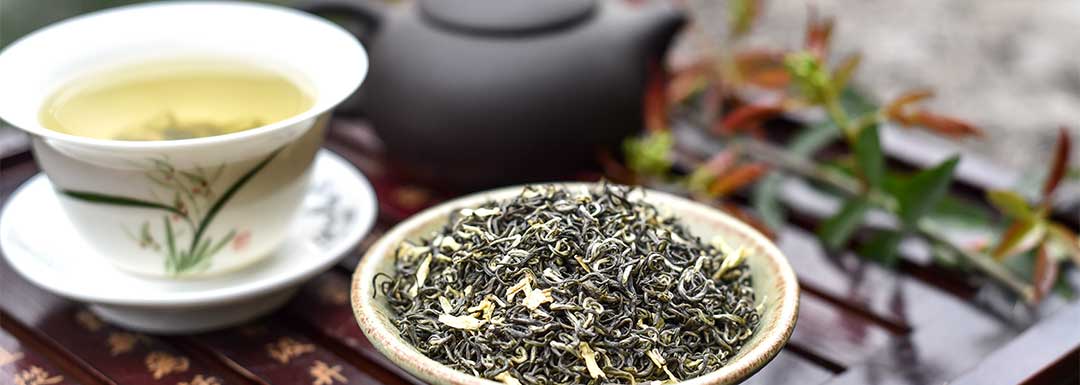
If you have ever had the pleasure of visiting a Chinese teahouse, you would have seen that there are a great many different teas for you to taste. However, genuine Chinese teas - those that come from the Camellia sinensis tree - fall into six basic categories, each one the result of a particular processing sequence.
The six types of tea are: green tea, white tea, yellow tea, oolong tea, black tea, and dark tea. However, the use of colors to classify the types of tea can be a little confusing. After processing the leaves of each of the types of tea do have a different appearance and in the west, the teas are often described according to the color of the leaves (such as black or green). However in China the name refers to the color of the brew, such as "hong cha" (red tea), as the black tea leaves actually produce a red tea when brewed. Of course, in the west, the term "black tea" is also used to refer to (black) tea when that is drunk without added milk, and "white tea" can refer to black tea with added milk.
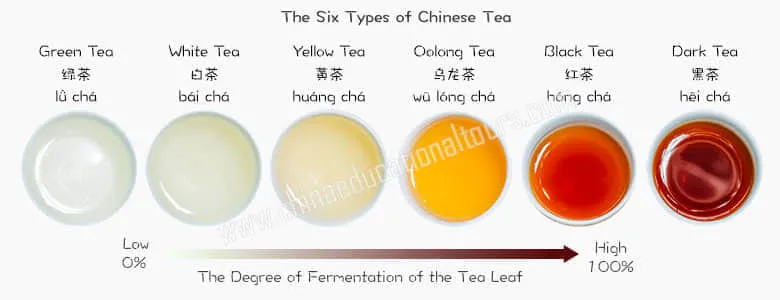
Fermentation is a vital part of the process of tea production, and it is essentially this step that results in the different varieties. (The word 'fermentation' is also used to describe the process of beer and wine production, where added bacteria convert sugar to alcohol, but this is not the same as tea 'fermentation'.) Applied to tea, the word refers to oxidation, and occurs when the leaves are exposed to air. Fully fermented teas, such as black (or 'red') teas are withered and rolled to fully expose the leaves to oxidation. Fermentation is controlled by adding heat through either pan firing or steaming. In green teas the fermentation is minimized and controlled by applying heat to the leaves almost immediately after picking, sealing in the grassy flavors and rich nutrients.
In the end it is the percentage of fermentation that actually differentiates between the various types of tea, with green tea being less than 5 %, white tea 5-10%, yellow tea less than 10%, oolong tea 10-60%, black tea 80-85% and dark tea 100%.
1. Green Tea
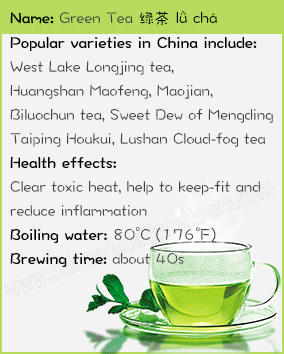
Green tea ( 绿茶 lǜ chá ) is the most popular, and one of the oldest, types of Chinese tea, and produced in the greatest quantities. The tea leaves are un-wilted, and unoxidized. The leaves are processed through careful steaming, frying and sun-drying to remove the moisture and bring out the fragrance.
There are a number of famous varieties within the Chinese green tea type, largely due to where the trees were cultivated.
West Lake Longjing tea is famous and has been special from as early as the Tang dynasty when areas near West Lake were already growing tea. The tea is particularly sought after for its beautifully shaped leaves, green color, strong fragrance, sweet taste, and the aftertaste.
The tea grown on Mount Huangshan, in Anhui Province, is known as Maojian tea and is also considered special. The leaves are covered with fine white hairs, and are each shaped like a mountain, and the tea itself tastes fresh and pure with a lingering aftertaste.
Then there is Bilochun tea, from Mount Dongting in Jiangsu, considered special for its luscious fragrance. It is so pleasant to watch the curled leaves unfold as the hot water is poured, that it is recommended to drink it in a glass.
And from Sichuan province comes the green tea known as Sweet Dew of Mengding, which is regarded as a holy, celestial tea due to its association with Buddhism. The tea is tender, green, and moist, and tastes better on the second brew.
Green tea is considered the healthiest tea to drink as it is loaded with antioxidants and nutrients that have powerful effects on the body. Its benefits include improved brain function, help with fat loss, and a lowered risk of cancer.
2. White Tea
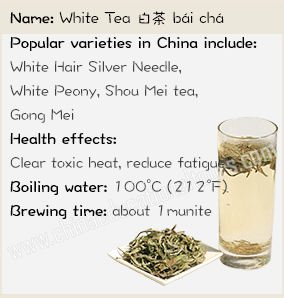
White tea ('bai cha')undergoes the least processing of all teas. Traditionally, in China, white tea was picked only a few days of the year, when fine white hairs appeared on the tender shoots. The tea shoots are allowed to wither then dry to prevent oxidization.
Two varieties of white tea are good representatives of white tea - White Hair Silver Needle, and White Peony, both of which are produced in Fujian. The tea has delicate flavors and aromas.
3. Yellow Tea
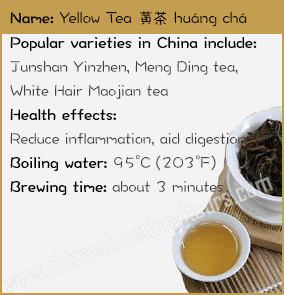
The discovery of yellow tea ('huang cha') was another happy accident. When making green tea, after the leaves were finished, kneaded and twisted, if they were not dried properly they would turn yellow. At first, people naturally considered the tea to be bad green tea, but gradually people came to enjoy the different flavor and it eventually became one of the six major types of tea. The tea is un-wilted, and unoxidized, but fermented as it is allowed to turn yellow.
4. Oolong Tea
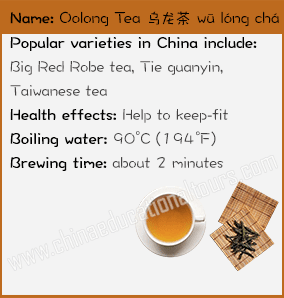
Oolong tea ('qing cha' or 'wu long cha') is often written with the Chinese (pinyin) spelling, 'wulong' tea.
This tea type lies somewhere between black and green tea, in that it is a semi-fermented tea, but the finishing technique is like green tea. It is wilted, bruised, and partially oxidized. It has the fresh, clean flavor of green tea, as well as the thick, luscious fragrance of black tea. It is grown mainly in Fujian and Guangdong, as well as Taiwan.
There are also some special and notable oolong teas, for example: Tie Guanyin from Anxi, in Fujian, the drinking of which is close to a religious experience; Wuyi rock tea is a delicate oolong, and the best known; Red robe has a history of over 300 years and is the best Wuyi rock tea.
It is believed that oolong tea reduces the risk of heart disease, helps fight obesity, lowers the risk of cancer, helps prevent diabetes, is high in disease-fighting antioxidants, decreases inflammation, supports a healthy brain and prevents bone loss.
5. Black Tea
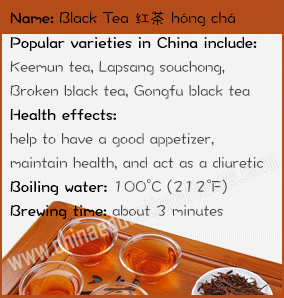
Black tea ('hong cha', red tea) is the most widely produced and drunk tea, and the best known amongst westerners. This tea is wilted, sometimes crushed, and fully oxidized. While in English it is commonly referred to as black tea, the Chinese generally know it as red tea, as red is the color of the liquid beverage. Rather than going through the green steaming or green frying processes, black tea is fermented, causing chemical reactions and changing the color. Black tea first appeared during the Qing dynasty, but by the end of that era it was the main type of tea exported to Europe and America. In western countries particularly, black tea is often drunk with additions such as milk, sugar, honey, or lemon.
There are three varieties of black tea: Gongfu black tea, small piece black tea, and broken black tea. Small piece black tea is the earliest black tea of China, produced near Fujian and Chong'an. Broken black tea was developed in India, produced in Sri Lanka, and trials were started in China in the 1950's. The Chinese specialty Gongfu black tea was developed from small piece black tea, and is China's most representative black tea.
6. Dark tea
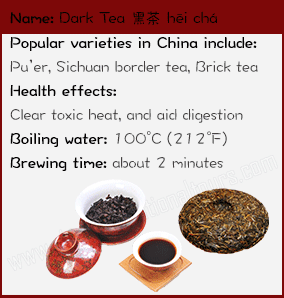
Dark tea ('hei cha', black tea) was invented by accident. As tea had to be transported over long distances, by sea and on horseback, alternating damp and dry conditions altered the composition of the tea, and turned it a blackish-brown. And yet the fragrance of the tea was very special, and this type of tea, known as Pu'er tea, soon became a local favorite and has been purposely produced in Yunnan province for 2,000 years. The Chinese name means 'black tea', but it is very different from what westerners call back tea (which Chinese know as red tea).
There are two types of Pu'er, known as Raw Pu'er, which is made through simple sun-drying, and Ripe Pu'er, which is made by sprinkling water over a 'heating pile' of leaves to induce fermentation. The longer it is preserved, the better it tastes, with raw Pu'er being at its best after about 10 years, and ripe Pu'er reaching its best fragrance after 2 or 3 years.
Because it is fully oxidized, Pu'er tea has a lower antioxidant content than white or green tea, but it is credited with many health benefits such as promotion of weight loss, reduction of serum cholesterol, and cardiovascular protection.

OR
Are you eager to begin your Chinese cultural journey?
Drop us a line and we will promptly connect you with our leading China expert!
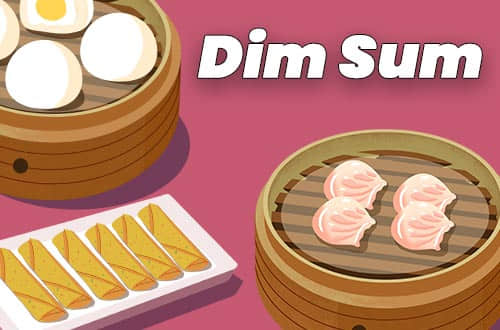 Dim Sum
Dim Sum  Chinese Beverages
Chinese Beverages 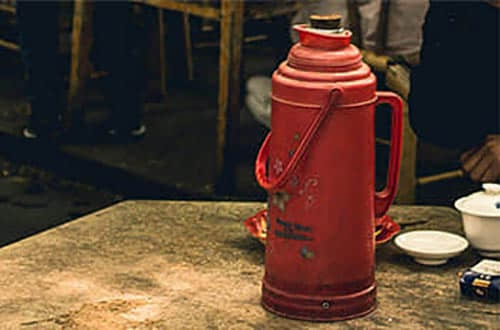 Hot Water in China
Hot Water in China 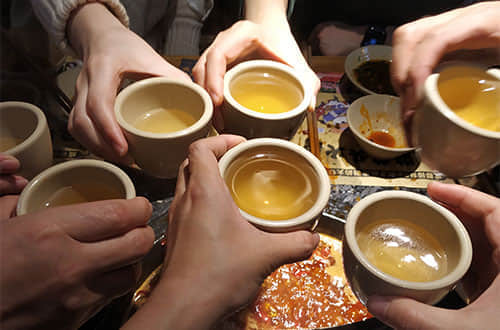 Ganbei (Bottoms up) - Chinese Drinking Culture
Ganbei (Bottoms up) - Chinese Drinking Culture